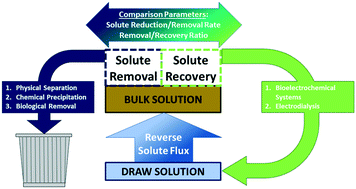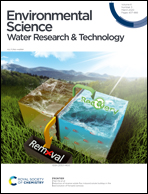Reduction of reverse solute flux induced solute buildup in the feed solution of forward osmosis†
Abstract
Forward osmosis (FO) has shown advancement towards recovery of useful water from various waste streams. A major issue that arises is the accumulation of salts due to reverse solute flux (RSF) from a draw solution into a feed solution that can result in several negative effects such as decreased water flux and inhibition of biological activities. This paper aims to provide a concise discussion and analysis of methods that can help to alleviate the effects of solute buildup. New parameters, solute removal/recovery rate (SRR) and removal/recovery ratio (ReR), are proposed to help better define the performance of reducing solute buildup and employed in case studies to evaluate selected reduction methods. Solute removal can be accomplished by physical separation, chemical precipitation, and biological removal. Recovery of solutes, one step beyond removal, is discussed and demonstrated by using bioelectrochemical systems and electrodialysis as examples. This work has highlighted the concerns associated with solute buildup and will encourage further exploration of effective tools to mitigate solute buildup for improved performance of FO-based water/wastewater systems.

- This article is part of the themed collection: Environmental Science: Water Research & Technology Cover Art


 Please wait while we load your content...
Please wait while we load your content...